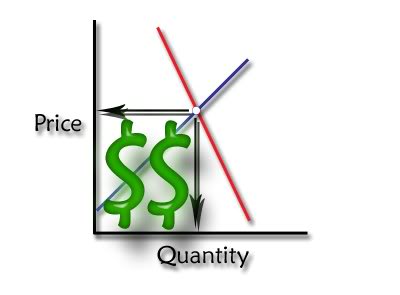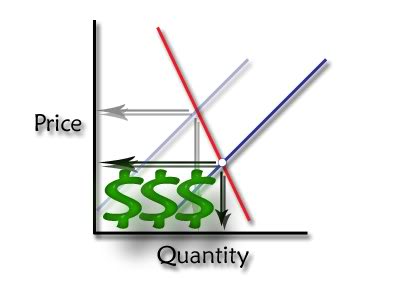23,000 Dead In Mexico's Drug Wars (And How We Caused It)

A leaked government report indicates that nearly 23,000 people have died in Mexico's violent drug wars in the last three years alone. But it doesn't have to be this way.
Any economist armed with basic microeconomic theory could explain how U.S. drug policies create the perverse incentives that have fueled the violence- and how to fix these policies to end the carnage.
Legalizing marijuana in California would be a tremendous step in the right direction. Though it may seem counter-intuitive, economists understand that legalizing marijuana would greatly decrease its value and put an end to the violent drug cartel that currently profits from its sale (and uses those profits to secure future profits by purchasing arms and murdering competitors).
Here's why:
The following is a microeconomic graph with a short primer on how to read it. If you already know how to read it, you can skip down to the next section.

The graph above depicts quantity on the x-axis and price on the y-axis, showing how the two relate. The red line is a demand curve and illustrates The Law of Demand- if something is cheaper you are willing to buy more of it and if something is more expensive you buy less. That's why as you follow the demand curve, when price goes down, the quantity demanded of a good goes up. The blue line is the supply curve, which illustrates The Law of Supply- that it is less lucrative to supply a good as the good's price decreases, so suppliers will want to supply less of it. Conversely- the more highly priced the good, the more of it they want to supply.
Suppliers can't sell more of a good than buyers are willing to buy and buyers can't buy more of a good than suppliers are willing to supply, so the point where the interests of all buyers and all suppliers in a market meet determines the quantity of goods produced and what the price of each unit of that good is. This is the place where the two lines intersect and it is called equilibrium. The total value of that market is the quantity of goods sold times the price of each individual unit, which is graphically represented by the square created by the two arrows and the two axes.
The Market For Marijuana In The United States
The graph below depicts the market for marijuana in the United States. See how the demand curve is steeper than in the graph above? That's because drugs like marijuana have what economists call inelastic demand- as the price of marijuana increases, the quantity demanded decreases at a smaller rate than for other goods. In plain English- consumers are less responsive to price changes. They are willing to pay higher prices to get their fix.

Notice any other differences? The supply curve is far to the left side of the graph. This is because the supply of marijuana in the United States is restricted because it is illegal and even the black market supply is often interdicted and destroyed by police. This combination- a good with an inelastic demand, plus an artifically restricted supply has a result that any economist can predict: artifically high prices. These high prices are what make the market for marijuana so lucrative that smugglers in Mexico and border cities are willing to kill each other over the profits, so lucrative that drug-dealers will fight turf wars to cash in on the loot.
The Market For Marijuana if California Legalizes
If California were to pass the Tax Cannabis Act, legalizing the cultivation, possession, and recreational use of marijuana by adults over 21, the market for it would radically change. Supply would no longer be restricted, as represented by the rightward shift in the blue supply curve below. But look what this does to the price of marijuana and even to the overall value of the industry. They both drastically decrease!

Economists can predict this kind of result because as I noted earlier, the demand curve for drugs is inelastic. As supply increases, every increase in the quantity of marijuana is significantly outdone by the corresponding decrease in per unit price. As prices drop, the market for marijuana will no longer be so artifically lucrative as to incentivize perverse and violent behavior. Furthermore, illegal dealers will be outpriced by the onslaught of new, legal suppliers and will lose their business nearly overnight- cleaning up bad neighborhoods with one fell swoop.
Why it matters
Sure, lines on a graph don't really matter, but this is more than just theory. Those lines represent something that does matter- human action and motivation. Ending the violence and instability in Mexico, putting drug dealing thugs out of business to clean up our streets, letting casual marijuana users continue living with their families and working at their productive jobs instead of locking them up (at the taxpayer's expense)- all of these things affect real people's lives.
23,000 people have died in the last three years alone because we do not consider the economic implications of the laws we pass. That matters. If we think economically, we can better determine why people act the way they do, how policies affect their lives, and how best to solve our society's problems.
-------------
All images above are © 2009 - 2010
by W. E. Messamore All Rights Reserved
Photo Credit: Claudio Toledo / Flickr




